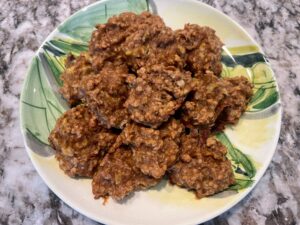Kimchi is a classic Korean dish famous for its spicy, tangy flavor. It’s a beloved traditional food in Korea, where no meal feels complete without some form of kimchi. While there are many types of kimchi, cabbage kimchi is the most well-known and versatile. This recipe follows my mother’s traditional method, which she’s used all her life. Although she used to add sugar in her original homemade kimchi recipe, she now skips it and uses natural ingredients for sweetness. The result is a healthier vegan kimchi that still captures the authentic taste and delicious flavor.
Fond Memories from My Childhood
My connection to kimchi goes back to my childhood in Korea, where it was a special part of our lives. I remember how my mother and our neighbors would gather each year to make kimchi. It wasn’t just about preparing food; it was a lively, festive event that turned into a community celebration.
Everyone had their own unique homemade kimchi recipes mostly with sugar, but my mother’s stood out for being both simple and healthy. I loved the way all the ladies would come together, chatting and laughing as they worked.
This annual gathering was a big deal for us and left a lasting impression. It wasn’t just about making kimchi; it was about the shared joy and cultural significance of this beloved Korean dish.
Homemade vs. Store-Bought Kimchis
Kimchi comes in many different kinds, with over 100 varieties to choose from. The most common ones are baechu kimchi (made with napa cabbage), water kimchi, and ggakdugi (cubed radish kimchi). Kimchi has become so popular worldwide that you can find it in most local markets.
However, store-bought kimchi often doesn’t match the flavor of homemade versions. Many commercial brands add sugar, preservatives like MSG, and other ingredients that can affect the taste and authenticity.
For a truly delicious and traditional kimchi experience, you can buy it from Korean stores or, even better, make it yourself. So, let me show you how to create your own kimchi with this easy kimchi recipe, without any added sugar or preservatives.
Homemade Kimchi Recipe Without Added Sugar
My homemade vegan kimchi recipe might not be the traditional version you’d find in Korea, as that process is more complex. However, I’ve simplified the recipe and made it vegan by leaving out fish sauce and refined sugar.
While it might not taste exactly like the traditional kind, I think it’s still very delicious and healthier. This recipe shows how kimchi can be adapted to fit different diets. So here it is: a homemade vegan kimchi recipe using all-natural ingredients, free from refined sugar.

Ingredients
- 2 small or 1 large Napa cabbage
- 1 small ripe apple or pear in place of sugar
- 2 whole bulbs of garlic, peeled and minced
- 1 tablespoon minced ginger
- 1 medium sweet onion
- 1 bunch of green onions, cut into 1-inch pieces
- 1 cup coarse sea salt (do not use regular table salt) for soaking, plus 2-3 tablespoons for seasoning
- 1 to 1 1/2 cups Korean red pepper flakes (make sure to use flakes, not fine powder)
Preparing Napa Cabbage
- Slice the cabbage in half lengthwise. Remove the core and cut the cabbage into small pieces, about 1 to 1 1/2 inches square.
- Place the cabbage in a large tub and cover with 5 to 6 cups of water. Sprinkle 1 cup of coarse sea salt over the cabbage and mix well. If you want to speed up the wilting process, you can add a bit more salt. Let the cabbage sit for about 30 minutes, or until wilted.
- Rinse the cabbage thoroughly in clean water. Transfer it to a large strainer and let it drain for about 15 minutes.
- Move the cabbage to a large mixing bowl or tub.
Blending and Mixing
- In a blender, combine the garlic, ginger, onion, and apple or pear.
- Then, add the blended mixture, along with additional salt and the Korean red pepper flakes, to the mixing bowl with the cabbage.
- Use your hands to mix everything thoroughly for about 10 minutes. Also, if you have disposable kitchen gloves, wear them to avoid burning your hands from the red pepper.
Fermenting
Transfer the homemade kimchi to a large Tupperware or a glass jar with a tight lid. Then, press the kimchi down and pack it in, but leave about 2 inches of space at the top. As it ferments, it will start bubbling and expanding, so don’t overfill the container. You’ll also notice a change in smell as it ferments.
If you’re making kimchi in the summer, leave it at room temperature on the kitchen counter for about 24 hours. In the winter, you can also let it sit out for another 24 hours if you want it fully fermented before refrigerating. It will continue to ferment in the fridge, so it’s fine to refrigerate it before it’s completely fermented.
After the first 6 hours of fermentation, taste the juice and add a little more kosher salt if needed. Do this before you refrigerate it. Adding salt after fermentation can make the kimchi taste bitter, so adjust the salt before it’s fully fermented and chilled.
Storing
In Korea, many people use a special kimchi refrigerator that keeps it at about 32°F. At this temperature, kimchi can last from 3 to 6 months before it starts to taste sour.
In a regular refrigerator, set at 37°F, homemade kimchi will last about one month. Over time, it will become more sour and wilted. If you’re using a regular fridge, store the kimchi in the coldest part.
Too much fermentation will make kimchi sour, which can be good if you like that flavor. My daughters enjoy more fermented kimchi, while I prefer it fresh and crisp.
Fresh kimchi is great as a side dish and pairs well with many foods. On the other hand, sour kimchi is perfect for cooking. It’s ideal for making dishes like kimchi soup, kimchi pancakes, kimchi fried rice, and kimchi potstickers.

Delicious Homemade Vegan Kimchi
Making homemade vegan kimchi without added sugar is a great way to enjoy this classic Korean dish while keeping it plant-based. By using fresh ingredients and skipping the sugar, you end up with a healthier and more authentic kimchi. It’s delicious whether you eat it fresh as a side dish or use it in recipes. Try making it yourself and see how easy it is to adapt this traditional favorite to suit your diet.














